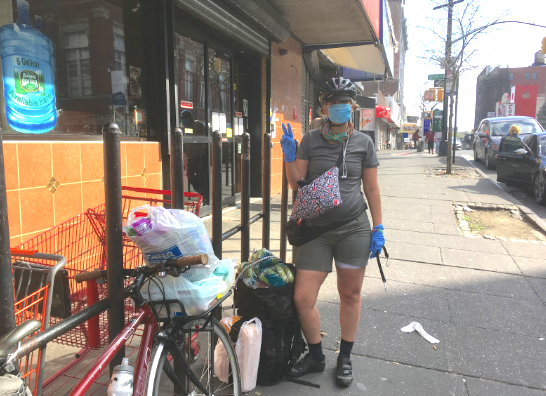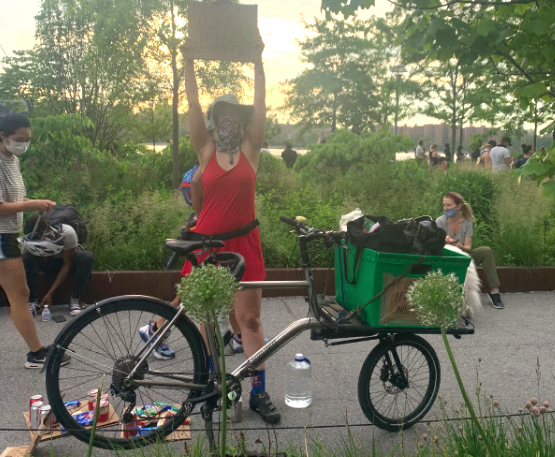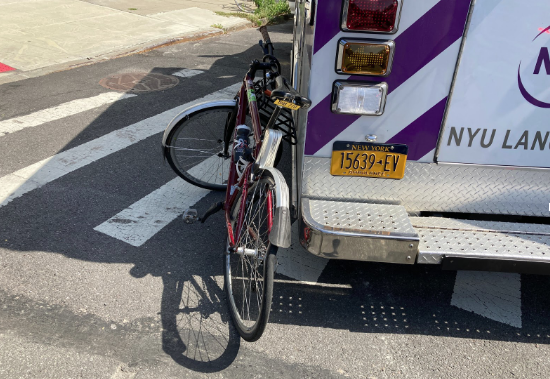A driver plowed into me from behind shortly after noon on Sept. 8 while I was riding in the bike lane on Smith Street in Brooklyn. It was not an "accident" or negligence; it was a brazen, deliberate act of violence that attacked my body, my livelihood, my identity, and my autonomy.
Witnesses described how the driver maneuvered his vehicle from stalled traffic on Smith Street, took aim at my back as I turned right onto Fourth Street, and mashed the gas pedal. He did not stop when he hit me. Instead, he accelerated again. The physics of the crash — impact, seconds, the measurements differentiating between mutilation and death — elude me. I was swallowed in a tumult of light and crunching metal. All I know is that, instead of being thrown in front of his crossover SUV, I landed face-up on the sidewalk — wordless and gasping, with all the air dashed from my lungs.
That I was immediately surrounded by about a dozen New Yorkers speaks to my attacker’s feelings of impunity: He mowed me down on a Tuesday afternoon, next to a crowded cafe patio in residential Carroll Gardens. Witnesses recorded his license plate — only to be informed by responding officers that no such registration existed, meaning he was driving with falsified plates. The only other thing I know for sure is that my attacker got away, disappearing into a city some have declared “dead” despite streets teeming with people, many on bikes.
I later learned that at least one bystander had put his body in front of my attacker’s car in an attempt to prevent him from leaving the scene — to no avail.
Immediately after the hit-and-run, I kept repeating “I’m OK” like a prayer or a line from a script. I work as a courier, and my attack happened while I was on the clock. I texted my boss from the ambulance, assuring him that while I couldn’t finish my shift, I was “OK.” My body shook; my left side was tender; my neck and shoulders felt sore. I carefully typed ginger reassurances to my brother with my bruised hands, cognitive dissonance rattling me as I glimpsed my legs strapped into a stretcher, the blue striped socks I had selected that morning suddenly an artifact of the crash.

The EMTs wanted to take me to the hospital, but because I had no broken bones or gushing wounds — and little insurance — a potentially bankrupting ambulance ride to the ER amid COVID did not appeal. “I’m OK,” I insisted, just wanting to hunker down somewhere safe. I signed whatever they put in front of my face so I could get out of there and do my best at making that true.
Since my attack, I have realized that, yes, I am OK. I am alive. I escaped serious injury, which, according to witness accounts and the catastrophic damage to my bicycle, might be miraculous (if you believe in that sort of thing). Yet I am reckoning with being the victim of a violent assault committed by a driver who weaponized his vehicle against me in a city in which car-centric policies, inadequate infrastructure, biased policing and incompetent elected officials have dehumanized cyclists to the point where this man not only knew he would get away with harming me, a cyclist, with his vehicle, he likely felt entitled to do so.
He lives in New York City in 2020 where, in an effort to stave off congestion, Mayor de Blasio has urged New Yorkers not to buy cars — even as he refuses to act on promised initiatives and policies that will make riding bicycles safer.

This is a city in which the deaths of cyclists in traffic violence were long met with ticketing blitzes that target the potential victims — cyclists — rather than motorists. It is also a city at the epicenter of the pandemic, in which bicyclists mobilized to provide neighbors with groceries and medication through mutual-aid networks while officials busied themselves with press conferences.
Bicycles also buttress the Black Lives Matter movement, which has led to instances of cops targeting cyclists for arrest at protests. Cycling has become a de-facto transit option as bureaucratic infighting and COVID render the MTA less reliable and potentially unsafe. Cycling has helped New York City to survive the pandemic. The record numbers taking to the streets on two wheels offer proof of life to those declaring our city dead.
I am grateful to the New Yorkers who took care of me while I was incapacitated on the sidewalk, waiting for the “official response” of the ambulance and police. They kept me safe and still.
I was hit by a driver today in a deliberate act of violence, while riding in the bike lane following traffic laws. My work bike is likely totaled. My wrist & elbow are banged up. My anxiety, dread, & depression are thru the roof. Trying to hang in there. It’s hard. #bikenyc pic.twitter.com/5LD2bXL62I
— Morgan L. Sykes (@morganlsykes) September 8, 2020
During my four years in New York, I have seen no shortage of heroism from everyday New Yorkers. Our collective kindness and empathy shows why life is worth living. I challenge those in power to act as heroically as my neighbors: Cycling should not be dangerous in New York City, and the traffic violence costing New Yorkers their lives represents a colossal failure that rests squarely on policy-makers.
The streets are for the people. They do not belong to cars, which are unsustainable, congestion-generating, expensive, and exclusive. The streets should be safe for New Yorkers in all our humanity — of every age, ability, color, and identity. Elected officials: You are responsible for the culture of risk and violence that endangers New Yorkers on bicycles. Policing will not fix it. We need structural, cultural change that places human lives over the speed and convenience of car drivers. We will never stop riding. Please do what’s necessary to keep us safe while we keep this city alive.
I do not want to die on the streets of New York City under the wheels of some furious machine.
Morgan L. Sykes (@morganlsykes) is a bike courier and freelance writer.







